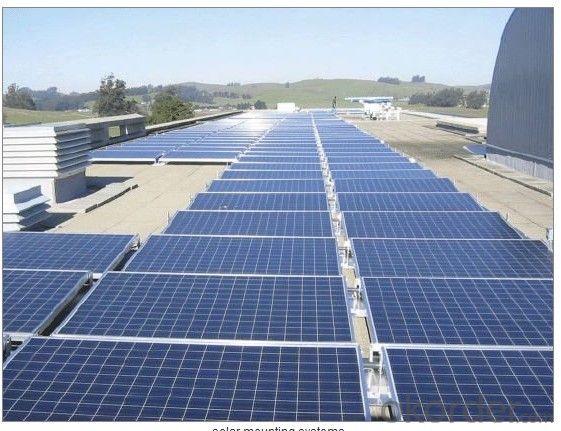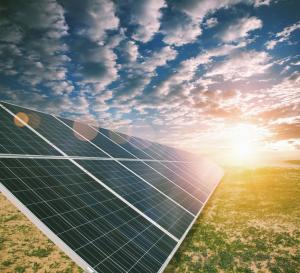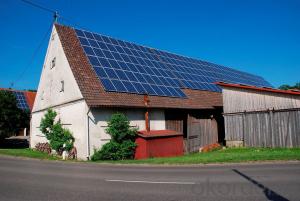310W Polycrystalline Silicon Solar Panel
- Loading Port:
- Ningbo
- Payment Terms:
- TT OR LC
- Min Order Qty:
- 200000 watt
- Supply Capability:
- 20000000 watt/month
OKorder Service Pledge
OKorder Financial Service
You Might Also Like
Introduction
This installation Manual contains essential information for the electrical and mechanical installation that your must know before installing CUSTOMER PV modules. This also contains safety information you need to be familiar with .All the information described in this manual are the intellectual property of CNBM and based on the technologies and experiences that have been acquired and accumulated in the long history of CUSTOMER. This document does not constitute a warranty, expressed or implied.
CUSTOMER does not assume responsibility and expressly disclaims liability for loss, damage, or expense arising out of in anyway connected with installation, operation, use or maintenance of the PV modules. No responsibility is assumed by CUSTOMER for any infringement of patents or other rights of third parties that may result from use of PV module.
CUSTOMER reserves the right to make changes to the product, specifications or installation manual without prior notice.
Solar cell module production process
Line called packaging line components, packaging is the production of solar cells a key step in the packaging process without a good, multi-well battery is also not a good component of production boards. Battery package not only the battery life is guaranteed, but also to enhance the combat strength of the battery. Product quality and high service life is to win can be the key to customer satisfaction, so the quality of components of the package board is very important.

Data sheet
Maximum power | 310W |
Cell type(mm) | Polycrystalline solar cell 156*156 |
Number of cell(pcs) | 72(6*12) |
Manufacture site | China |
Open-circuit voltage(voc) | 45V |
Maximum power voltage(vmp) | 37V |
Short-circuit current(isc) | 8.8A |
Optimum operating current(imp) | 8.38A |
Power tolerance | 0~+5W |
Module efficiency | 16% |
Dimensions(mm) | 1956*992*40 |
Weight | 27 kg |
Backsheet | Silver |
Frame Colar | White |
Frame | Anodized Aluminum Alloy |
FAQ:
1. How long will my inquiry get response?
Your inquiry related to our products or prices will be replied within 24 hours.
2. Can I get professional service and suggestion?
Well-trained and experienced staffs to answer all your questions in fluent English.
3. Do you accept OEM or customized design?
OEM & ODM, any your customized lightings we can help you to design and put into product.
4. What if I need specific design?
Distributorship are offered for your unique design and some our current models.
- Q:Is there a material that is capable of absorbing enough UV radiation to make it worth using as a flexible solar cell?Not flexible as in aluminum, but a material such as plastic (polycarbonate).
- Of Coarse! In fact flexible solar panels have already been invented. Ever hear of a solar panel shirt? Instead of the standard crystalline silicon cell these new solar panels use a flexible polymorphous silicon cell to pull in power from the sun's rays. They can be placed on clothing, cell phones, and virtually anything else.
- Q:Can solar panels be installed on farmlands or agricultural fields?
- Yes, solar panels can be installed on farmlands or agricultural fields. In fact, many farmers and landowners are increasingly using their land for solar energy production as it can provide additional income and sustainable farming practices. Solar panels can be mounted on ground-mounted systems or integrated into structures like barns or sheds without interfering with farming operations. Additionally, solar installations can offer benefits such as reduced energy costs and promoting environmental sustainability in the agriculture sector.
- Q:Can solar panels be used in areas with high levels of UV radiation?
- Yes, solar panels can be used in areas with high levels of UV radiation. In fact, they are designed to withstand and harness UV rays from the sun to generate electricity. The materials used in solar panels are specifically chosen to endure high UV exposure, ensuring their efficiency and longevity even in such conditions.
- Q:If a solar panel has a power rate of 80 Watts and efficiency of lets say 30%. Does that mean the maximum power this solar panel can generate is (30/00)*80=54 Watts or its just 80 Watts?
- Solar panels are tested in a lab that has a light the produces 000 watt/hrs per square meter. In these conditions your panel will produce 80 watt/hrs. If you would like to know what it does in really world conditions you have to find the sun-hours in your given area. A sun-hour is basically how many watt/hrs hit a square meter in a day. This number changes based on time of year, orientation, and temperature. Here in Fairbanks Alaska if the panel was at 90 degrees facing true south in October (.9 sun-hours) It would produce 80 X .9 X .8 (20% efficiency loss due to wires and controllers) it would produce 273.6 watt/hrs on average each day.
- Q:Can solar panels be used for powering outdoor signage?
- Yes, solar panels can be used to power outdoor signage. Solar panels convert sunlight into electricity, providing a sustainable and renewable energy source for outdoor signage. This eliminates the need for traditional electricity sources, reduces energy costs, and minimizes the environmental impact.
- Q:How are solar panels made?
- Solar panels are made using a complex manufacturing process that involves several key steps. First, high-quality silicon ingots are sliced into ultra-thin wafers. These wafers are then treated with various chemicals to enhance their electrical properties. Next, metal contacts are added to the front and back of the wafers, allowing for the flow of electricity. The wafers are then assembled into a module, encapsulated in a protective layer, and sealed with a glass cover. Finally, the completed solar panels undergo rigorous testing to ensure their efficiency and durability before being ready for installation.
- Q:Can solar panels be installed on schools or educational campuses?
- Yes, solar panels can be installed on schools or educational campuses. In fact, many educational institutions are increasingly adopting solar energy as a sustainable and cost-effective solution to meet their power needs. Installing solar panels on schools not only reduces electricity costs but also serves as an educational tool, allowing students to learn about renewable energy and environmental sustainability firsthand.
- Q:Can solar panels be used in areas with high levels of air humidity or moisture?
- Yes, solar panels can be used in areas with high levels of air humidity or moisture. While excessive moisture may slightly reduce the efficiency of solar panels, modern panels are designed to withstand a variety of weather conditions, including high humidity. Furthermore, regular maintenance and cleaning can help mitigate any potential impacts on performance.
- Q:How do solar panels affect the overall sustainability of a building?
- Solar panels can significantly enhance the overall sustainability of a building by generating clean and renewable energy. By harnessing the power of the sun, solar panels reduce the reliance on fossil fuels, resulting in lower greenhouse gas emissions and a smaller carbon footprint. Besides producing electricity, they can also provide heating and cooling, further reducing energy consumption. Additionally, solar panels contribute to energy independence, improve energy efficiency, and can even generate excess power that can be stored or fed back into the grid. Overall, solar panels play a crucial role in promoting sustainable practices and mitigating climate change impacts.
- Q:my dad wants to run all his lights in his shop on solar panels, he has 9 600 watt hps lights. how many solar panels would it take to pull this off
- dozens at a huge cost which only run in sunlight so not ideal for running lights, solar panels are just not economical or reliable, probably around $5000?
1. Manufacturer Overview |
|
|---|---|
| Location | |
| Year Established | |
| Annual Output Value | |
| Main Markets | |
| Company Certifications | |
2. Manufacturer Certificates |
|
|---|---|
| a) Certification Name | |
| Range | |
| Reference | |
| Validity Period | |
3. Manufacturer Capability |
|
|---|---|
| a)Trade Capacity | |
| Nearest Port | |
| Export Percentage | |
| No.of Employees in Trade Department | |
| Language Spoken: | |
| b)Factory Information | |
| Factory Size: | |
| No. of Production Lines | |
| Contract Manufacturing | |
| Product Price Range | |
Send your message to us
310W Polycrystalline Silicon Solar Panel
- Loading Port:
- Ningbo
- Payment Terms:
- TT OR LC
- Min Order Qty:
- 200000 watt
- Supply Capability:
- 20000000 watt/month
OKorder Service Pledge
OKorder Financial Service
Similar products
New products
Hot products
Related keywords





























